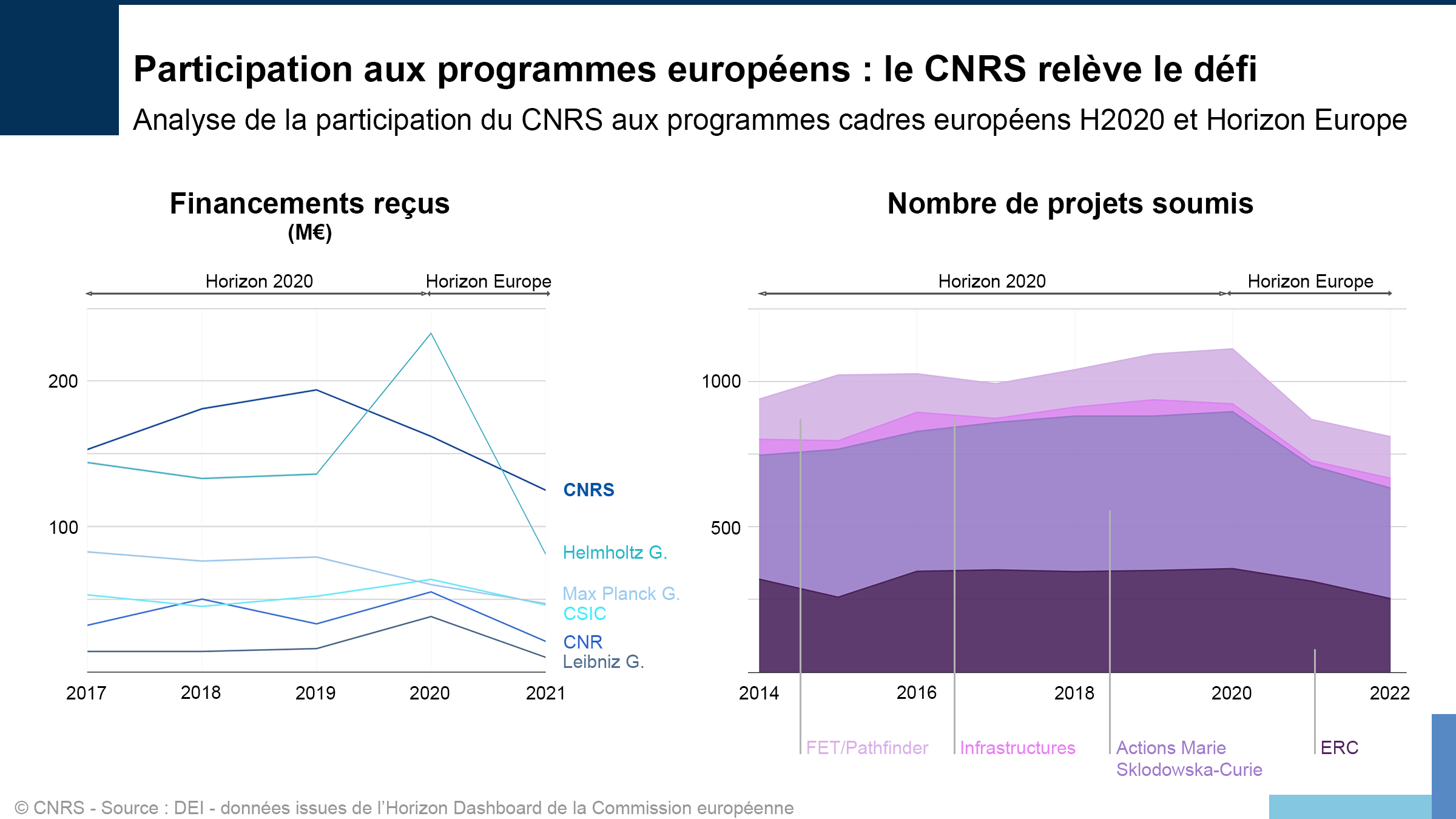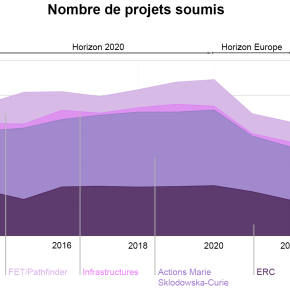
Participation in European programmes: How the CNRS is rising to the challenge
The CNRS has been the leading European beneficiary of the EU's framework programmes for research and innovation since 2014, the year of the H2020 framework programme's launch. This has given excellent results although disparities remain between schemes and disciplines. Strong initiatives are required to support the continued involvement of CNRS research teams in Europe.
"The CNRS can be proud of its performance at the European level but a detailed analysis has enabled us to define areas with room for improvement and what needs to be done," says Christelle Roy, head of the CNRS's European and International Affairs Department (DEI). The DEI analysed all the CNRS projects submitted and those that won in the framework of the European research and innovation framework programmes, Horizon 2020 (2014-2020) and Horizon Europe (2021 onwards).
The results: the CNRS is the leading European beneficiary of these programmes in terms of the number of projects its scientists participate in or coordinate and also of the total funding received. "The large number of CNRS researchers involved alone could be thought to explain these good results but the organisation is still in the lead among European national research organisations if performances are compared to the number of scientists employed", explains Etienne Snoeck, head of the DEI's Europe Unit who carried out this analysis.

In terms of funding received by the CNRS, the first provider of grants is the Council of the European Union (ERC1 ). In the H2020 programme, the total of 507 CNRS ERC projects represented 27% of the European projects the organisations took part in but accounted for 63% (€720m) of the funding received. Next come collaborative Research and Innovation Actions (RIA - 607 projects, €215M) and the Marie Sklodowska-Curie Actions (MSCA2 - 518 projects, €137m). The CNRS received a total of over €1.1 billion from the European Commission in the framework of H2020. As Etienne Snoeck points out, this financial contribution is "far from negligible" for CNRS laboratories and is enabling many teams to carry out research projects that are "innovative and ambitious and succeeded in a highly competitive selection process."
An exceptional success rate for ERC grants
The CNRS continues to have a high success rate for ERC grants with an average rate of around 20% for H2020. This is higher than both the French national (14%) and European (12%) average rates. The CNRS is the leading beneficiary of grants in 9 of the 10 panels3 in Physical Sciences and Engineering (PE) and was awarded 226 of the 409 French grants in this category. The organisation also leads the field in 3 of the 9 panels4 in Life Sciences (LS). The CNRS has slightly more difficulty in the Social Sciences & Humanities (SH) panels which is the case for the whole French national HSS community but nonetheless obtains more than 30% of French grants in this field and is also the leading grant recipient in the 'The study of the Human past' panel.
Just under 20%5 of CNRS researchers have submitted a European project to H2020 and a quarter of young CNRS researchers recruited between 2016 and 2022 were found to have applied for ERC Starting (StG) or Consolidator (CoG) grants. These would be encouraging figures but the last three years have seen a drop in applications, a trend that began in 2017 for StGs.
A fall in applications
A similar drop is found in the number of submissions of MSCA projects during the first two years of Horizon Europe. Fewer than 400 projects were submitted in 2021 and 2022 compared with an average of over 500 per year during Horizon 2020. However the number of grant winners remains at an average of 80 projects per year which of course represents an increasing overall success rate. Etienne Snoeck explains that "different communities use this tool in different ways depending on their specific requirements as regards PhD students and post-doctoral fellows".
The European framework programmes also offer tools enabling scientists to transfer their discoveries to the economic sphere (French link). One such scheme involves the Horizon Europe EIC6 'EIC Pathfinder' calls for projects that have replaced the H2020 'FET Open' calls. This tool is attracting a stable number of applications from CNRS teams (an average of 150 projects per year) with an average success rate of over 14%.
Encouraging collaborative projects
Over half of the Horizon Europe programme's budget (€52 billion) is devoted to societal challenges. These are grouped into six clusters7 that have replaced the H2020's seven "societal challenges"8 . The CNRS took part in over 600 of these thematic and collaborative RIA projects in H2020 but only coordinated 65 such actions. This trend can be seen to have continued in the first two years of Horizon Europe. Etienne Snoeck assumes that projects submitted in responses these calls for proposals need to have a Technology Readiness Level (TRL) that is "too high which could be prohibitive for some of the CNRS's basic research communities (French link)". Nonetheless he considers that these calls for proposals should logically "attract a much larger number of researchers" and can represent an "exhilarating experience that enables researchers to establish their own vision of their research in an international dynamic with a European label and a considerable budget". The fact that many European project coordinators "return to Europe" and submit other projects at a later date would tend to prove this hypothesis.
More support for submitting and managing European projects
The CNRS is rolling out a triple action plan from 2021 onwards involving encouragement, support and influence to maintain the organisation's involvement in the European Research Area (ERA) and increase its participation in the European Framework Programme.
Therefore support for researchers in setting up European projects has been reinforced by the recruitment of European project engineers (French acronym – IPE) throughout France as a complement to the network of a dozen such IPEs created in 2003 and coordinated by the CNRS's Brussels Office. A first wave of recruitment in 2022 led to around thirty IPEs joining the Partnership and Technology Transfer Departments (SPVs) of the 17 CNRS regional offices. These engineers support the existing awareness-raising and support initiatives implemented by the project leaders of these SPVs. A second wave is currently underway and will strengthen large-scale laboratories or groups of laboratories. The third wave is scheduled for 2024 with the three recruitment waves together intended to provide researchers throughout France with the support of around one hundred IPEs with expertise in setting up European projects. These engineers will also work for the CNRS sites' shared Europe units (French link) currently being set up in the framework of projects that have won the government's ASDESR9 call for projects: "We believe it is more effective to run these awareness-raising and support initiatives in collaboration with our local partners," explains Etienne Snoeck. European correspondents have also been appointed in all the laboratories under the supervisory authority of the CNRS. Their role is to disseminate European information and opportunities and liaise between laboratory teams and the SPVs, IPEs and European project officers in the Institutes. Most of the CNRS Institutes also support applicants by offering to review their projects and running coaching sessions (French link) for applicants and new project coordinators.
The Europe Units of the SPVs are supported by training, tools, networking and advice provided by the CNRS's Transversal Steering Support Mission (MTAP). Claire Werlen, the Director of the MTAP, explains that "the MTAP provides the SPVs with tools to support researchers on working with the administrative and financial aspects of European projects. This can extend to cross-disciplinary issues like ethics, sustainable development, intellectual property and open science while scientific support is provided by the Institutes. The idea is to make it as easy as possible to set up and manage projects on a day-to-day basis while also complying with the many demands made by the European Commission like justifying the use of funding. We are aware of the constraints this imposes but our objective is to secure the funding the CNRS receives to avoid having to repay large sums for non-compliance with funding rules," she adds.
Also, for the last two years, the 'AMORCE (French link) call for projects has provided support in setting up research projects with European coordination for all CNRS unit staff members wishing to coordinate a collaborative project in the framework of the Horizon Europe framework programme. This means that an IPE and funding of €10k are available to support successful applicants in creating a consortium and organising meetings to set up a project and write the project documents. This CNRS initiative to encourage its scientists to apply for European calls has very quickly proved fruitful as is shown by the increase in the number of projects submitted in the framework of this call, particularly for projects in the social sciences and humanities. Overall there were 17 submissions in 2022 and 34 in 2023 with 14 and 28 winners respectively
Increasing the CNRS's influence in Europe
The third prong of the plan aims to increase the influence of the CNRS on the ERA to position the organisation as a key player in Europe's main scientific challenges. In this context, the CNRS aims to influence the Horizon Europe work programmes by stressing the need to fund fundamental research and organising CNRS research communities to respond to the major challenges facing our society in a corporate manner. It is also a member of the G6 network of influence made up of the six main European multidisciplinary research organisations10 and has just published a set of recommendations for the next European Framework Programme (FP10). "We are working on these initiatives to enhance our influence directly with the European Commission through our Office in Brussels and also, for over a year now, through the Maison Irène et Fréderic Joliot-Curie (French link) which brings together our main French partners," explains Christelle Roy. "Although we of course aim for rapid results, it is important to make it clear that this is a long-term strategy", she concludes.
- 1The ERC offers various individual grants depending on the scientist's career level - Starting, Consolidator and Advanced Grants. There are also Proof of Concept and Synergy grants for teams of two to four researchers and their teams to work together on ambitious research projects.
- 2Marie Skłodowska-Curie Actions provide individual grants for researchers wishing to work for public research organisations or companies in other countries.
- 3Mathematics; Fundamental Constituents of Matter; Condensed Matter Physics; Physical and Analytical Chemical Sciences; Synthetic Chemistry and Materials; Systems and Communication Engineering; Products and Processes Engineering; Universe Sciences; Earth System Science.
- 4Molecular Biology, BioChemistry, Structural Biology & Molecular BioPhysics; Cellular and Developmental Biology; Ecology, Evolution and Environmental Biology.
- 5If the possible project re-submissions are included, this submission rate in relation to the population of CNRS researchers would be between 15 and 18%.
- 6The European Innovation Council (EIC) has a €10 billion budget over a seven-year period. Its mission is to identify, develop and intensify breakthrough technologies and innovations.
- 7Health; Culture, Creativity And Inclusive Society; Civil Security For Society; Digital, Industry and Space; Climate, Energy and Mobility; Food, Bio-Economy, Natural Resources, Agriculture and the Environment.
- 8Energy, the Environment, Food, Health, Safety, Inclusive Societies, Transport.
- 9To speed up higher education and research establishments' development strategies.
- 10The G6 brings together Europe's leading multidisciplinary research organisations in terms of skills, networks and infrastructures - the Consiglio Nazionale delle Ricerche (CNR, Italy), the CNRS (France), the Consejo Superior de Investigaciones Científicas (CSIC, Spain), the Helmholtz Association, the Leibniz Association and the Max Planck Society/MPG (Germany). As such it represents the interests of over 142,000 employees,


